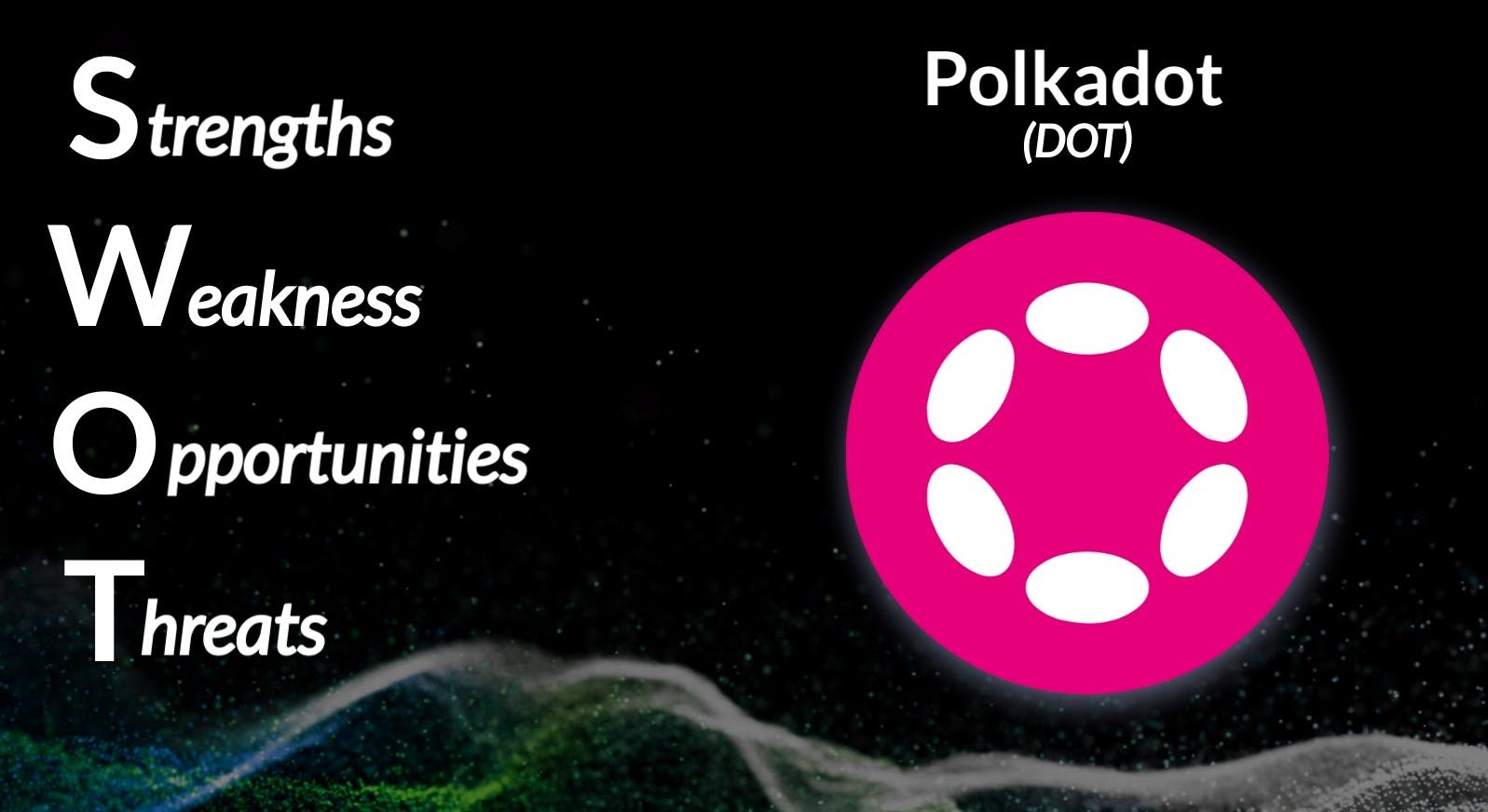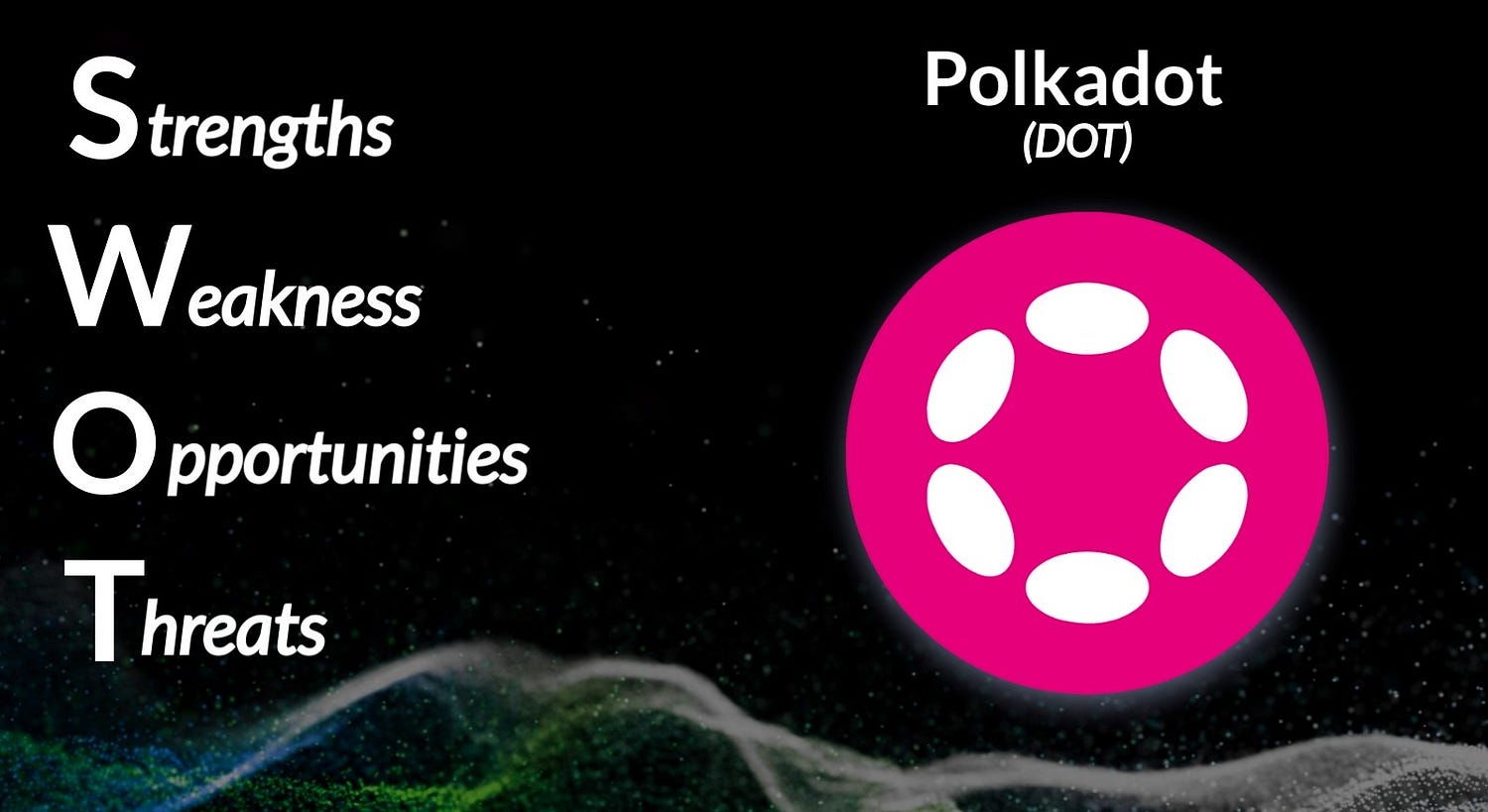
SWOT Analysis: Polkadot (DOT)
*Note: a SWOT analysis is an evaluation of the fundamental, operational, technical, social, economic, and even to some degree administrative elements of a project. This is not a model to be used for trading purposes. (NFA, DYOR)

Composed of four elements, Strengths, Weaknesses, Opportunities, and Threats, a SWOT analysis framework provides excellent insight for establishing a high-level understanding of the state of a project’s well-being through the lens of a birds-eye view.
It can help formulate decisions around which areas require more attention, set performance goals, and organize a foundational understanding of where a project is headed.
Rarely (if ever) used in crypto, it is time to apply this timeless method of evaluation to the digital asset space.
Today, Polkadot (DOT), the sharded, interoperable multi-chain blockchain network and layer-0 protocol, will get a SWOT.

1. Parachain Architecture
Polkadot’s mechanism for creating a multi-chain environment is based on the concept of Parachains, which are independent layer-1 blockchain networks with their own tokens, governance models, and functionality that are connected to the Polkadot Relay Chain. By having all Parachains connect to the Relay Chain, the entire ecosystem shares security primitives and is able to seamlessly transfer any arbitrary data between one another (including tokens). As is the case with almost everything in crypto/Web3, this is a novelty that must still prove itself over the test of time; however, the fact that these Parachains are established through token bonding (similar to staking) and have a two-year expiry which then forces the chain operators to bid and compete for their Parachain slot again.
2. XCM V3
Polkadot has developed its own cross-chain messaging protocol, as its interoperability solutions allow for the transference of data between different chains in the Polkadot ecosystem. While there has already been a fair share of brilliant interchain solutions, such as IBC from cosmos, already released into the crypto space, this specific version update to V3 of XCM introduces a significant improvement over any alternatives. Given the the trajectory of the overall crypto industry is headed into a multi-chain world, the presence of XCM positions Polkadot as a leading choice for new and evolving projects.
3. Developer Activity
Easily one of the most active projects in terms of full-time (750) and total (2,000) developers that are working on it. These numbers put it in second place only behind Ethereum; the next contender would be Comsos with around 500 full-time devs. When considering the complexity of Polkadot and (relatively) less infrastructure to work with, it is incredible how much attention they have been able to attract.
4. Launched OpenGov
Governance is a constant bottleneck when it comes to the speed of iteration around community-led proposals for decentralized environments. OpenGov has introduced a few interesting adjustments, namely its “no-referendum queue,” which allows for multiple processes to take place in parallel; in turn speeding up considerations and allowing users to prioritize what they want to rather than being forced to wait for prior ideas to pass. Another worthwhile modulation that must be paid homage to is the leveling of hierarchy, namely by displacing the council and technical committee structure with a Fellowship. There are other improvements such as the gestation and implementation periods but these are incremental, while the first two can potentially have exponential impacts.
5. Insane Scalability *promises
The crypto industry has long suffered from Vaporware, technology that promised solutions with grand visions that never actually materialized. That said, Polkadot’s teams and technical reputation give their extremely ambitious claims credence; while in recent history the network has been processing at approximately a 1,000 TPS level, the team plans on scaling it to the 1,000,000 TPS mark. Achieving such a lofty goal would certainly turn Polkadot into a momento of crypto history and give it a permanent legacy.
6. Forkless Upgrades
Forks are a contentious issue within the blockchain space, causing community fractures, technical delays, and economic shenanigans (duplicate networks with fake tokens). Polkadot is designed with a sophisticated adaption of the substrate framework that is resilient to forks, in turn helping to keep a high level of moral alignment between all of its ecosystem members.
7. DOT not required to pay Chain Fees
This is both a weakness and a strength. On the side of the strength, this frees up the team and networks that are trying to build their own projects without forcing end users to jump through too many hoops. By simplifying the process for projects to cater to their end users, adoption becomes inevitable.
1. Technical Complexity
Polkadot’s intelligent engineering designs and complexity might ultimately be an Achillies heel for it. Parachains, Parathreads, NPOS (Nominated Proof-of-Stake), XCMP, Collators, Fisherman, the amount of terminology, and novel design concepts that require developers and entrepreneurs to reframe their thinking around value creation, make Polkadot unappealing to many potential projects.
2. Non-EVM Compatible
The entire open blockchain industry has arguably been impacted the most with the advent of the EVM (not including blockchain tech itself). With an already wildly varied amount of projects arriving in a multitude of layers (L0, L1, L2) and in both EVM and Non-EVM network structures, those that have native compatibility with the EVM (especially those with interoperability at their core) tap into the most robust execution environment and smart contract system that has nothing remotely close to it in terms of adoption or tooling. Polkadot, as you might have already been able to deduce from the long intro in this section, is Non-EVM compatible.
3. Uncapped max supply
Inflation is the silent thief of economy opportunity. While there is always an argument to be made on the logical merits of inflationary systems that expand to invite more potential users into an ecosystem, the economic impact of it on the unit value and, in turn, unwary retail investors is measurable. Polkadot’s DOT token has a perpetual inflation policy that is distributed as a reward to stakes and allocated to the treasury.
4. DOT not required to pay Chain Fees
This is both a weakness and a strength. On the side of the weakness, this renders the DOT token incapable of capturing the value from transactional velocity. Somewhat counter-intuitive that a multi-chain ecosystem wouldn't try to pin their token to the gas-related activities of each individual chain.
1. Reputable Foundings
Polkadot has a founding team equipped with the industry's quintessential knowledge and capabilities. Brainchild of Gavin Wood, a technical co-founder of Ethereum and leading developer of the Solidity smart contract programming language; Gavin published the original Polkadot whitepaper in late 2016 and has since been able to build a team and rally many technical experts around his vision. Having such a strong intellectual foundation gives Polkadot a genuine opportunity to contend against the industry’s largest players with confidence.
2. Avoided SEC Scrutiny
Yes, according to the SEC, DOT is not a security. In the recent regulatory kerfuffle, Polkadot has somehow been able to avoid having its DOT token targeted by the SEC. The reasoning behind this, as explained by the Web3 Foundation, is that after long conversations directly with the SEC, they have been able to convince them that the maturation of the project and the evolution of its asset into a compliant archetype satisfies design principles sufficiently enough to not be considered a security. This gives the project an enormous superiority (at least in the frameworks of legality) to operate within every jurisdiction.
1. Free Market Forces Opt Out
Free market forces are the ultimate judge and jury when it comes to technology; adoption is everything. The Interoperability sector has been one that has seen the most genuine innovations, which (ironically) do not inter-operate with one another. Polkadot’s solution is competing with a slew of other scalable, interoperable Layer 0 protocols, including AVAX, Cosmos, Layer Zero, and others; if, for any reason, the market forces prefer one of or all others except Polkadot, then the project is effectively unnecessary.
2. Not Delivering on its Vision
While there is an abundance of scams, rugs, and shitcoin that build their projects around intentionally hurting others, sometimes there are natural, technological hurdles that impede a project’s development; human psychology, physics, regulatory, and other unanticipated occurrences. Polkadot’s lofty goals and advanced technologies leave it exposed to underdelivering, which can cause a domino effect to spiral out of control where investors leave, liquidity leaves, more investors leave until, ultimately, everything dries out.
The crypto industry has long suffered from Vaporware, technology that promised solutions with grand visions that never actually materialized. That said, Polkadot’s teams and technical reputation is difficult to rebuke.
Polkadot is definitely a chain that is geared more towards technically inclined, intelligent audiences, likely those with application solutions that are fit for enterprise-grade problems; this is not a degen chain.
The threats facing Polkadot are externalities that are prevalent throughout all crypto projects; however, given their glorious background, technical capability, and the monstrous amount of capital in their ecosystem, they should be held to a high standard and accountable for their words.
Complex… but promising.
Polkadot is one of the more silent, focused projects without the all-to-common obscene marketing tactics and wannabe influencers plaguing their ecosystem.
There is a very technically intensive roadmap/direction of development in the pipeline that would turn this simple SWOT into a multi-page micro thesis, for the sake of brevity, Polkadot is without a doubt one of the heavyweights. The elegance that the project approaches its brand and marketing with is somewhat reminiscent to giga-brain Web2 tech giants.
There feels to be underlying politics going on (yes, definitely between Polkadot and the government) but also between the genesis group of techno-anarchists that birthed the crypto industry we know today. Gavin is easily on the same frequency as Vitalik Buterin, Vlad Zamfir, Charles Hoskinson, and a select few others.
Of course the, only question most of us care about…
Would I invest in this bish?
Absolutely.
I am very bullish on the surrounding ecosystem of networks building around it, especially Moonbeam (GLMR).
I am very bullish on interoperability as a sector.
I super appreciate the calm, level-headed aura of the project.
Only one thing though, tokenomics are kinda weak; but I have a crawling feeling inside of me that Polkadot will address this at some point. If/When it does, fireworks baby.
If you know something that I don’t or feel as though I might have missed anything worth noting, please do share, I would tremendously appreciate some feedback.
Thank you so much for reading,
I hope this serves you well on your journey.
Live long and prosper 🥂


